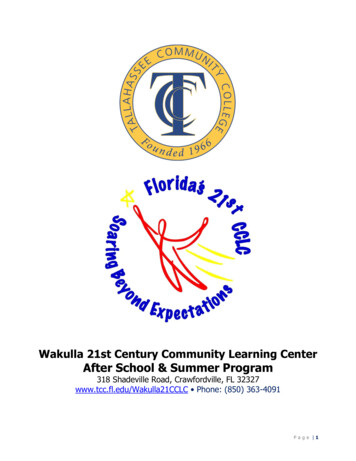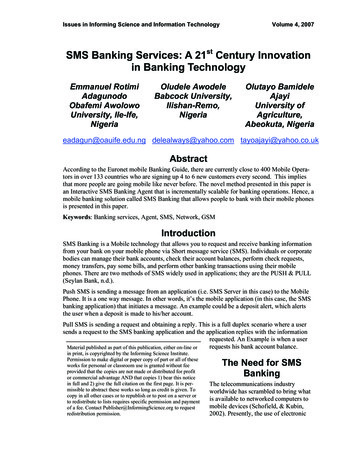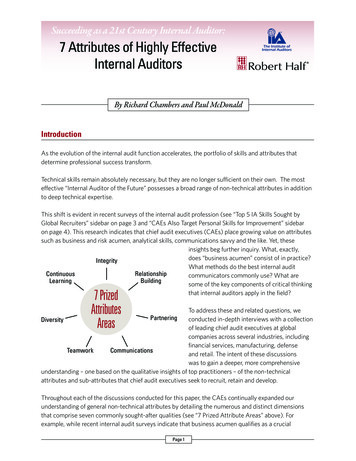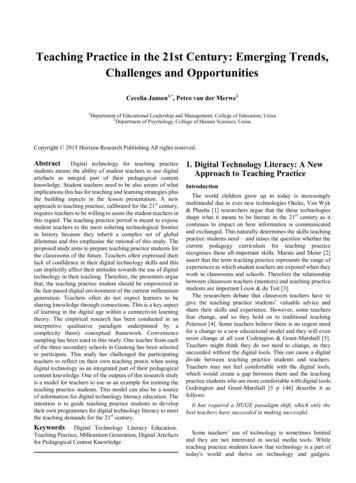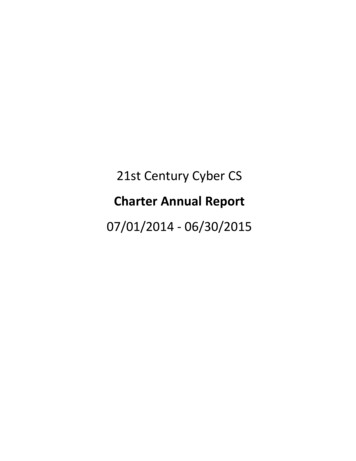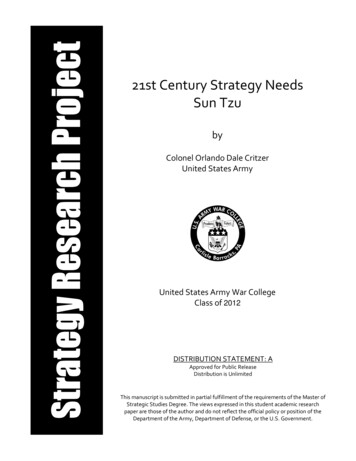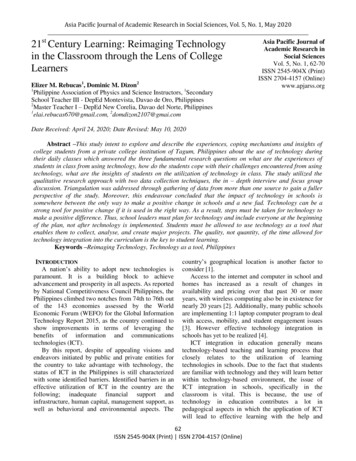
Transcription
Asia Pacific Journal of Academic Research in Social Sciences, Vol. 5, No. 1, May 2020stAsia Pacific Journal ofAcademic Research inSocial SciencesVol. 5, No. 1, 62-70ISSN 2545-904X (Print)ISSN 2704-4157 (Online)Elizer M. Rebucas1, Dominic M. Dizon2www.apjarss.org1Philippine Association of Physics and Science Instructors, 1SecondarySchool Teacher III - DepEd Montevista, Davao de Oro, Philippines2Master Teacher I – DepEd New Corelia, Davao del Norte, Philippines1elai.rebucas670@gmail.com, 2domdizon2107@gmai.com21 Century Learning: Reimaging Technologyin the Classroom through the Lens of CollegeLearnersDate Received: April 24, 2020; Date Revised: May 10, 2020Abstract –This study intent to explore and describe the experiences, coping mechanisms and insights ofcollege students from a private college institution of Tagum, Philippines about the use of technology duringtheir daily classes which answered the three fundamental research questions on what are the experiences ofstudents in class from using technology, how do the students cope with their challenges encountered from usingtechnology, what are the insights of students on the utilization of technology in class. The study utilized thequalitative research approach with two data collection techniques, the in – depth interview and focus groupdiscussion. Triangulation was addressed through gathering of data from more than one source to gain a fullerperspective of the study. Moreover, this endeavour concluded that the impact of technology in schools issomewhere between the only way to make a positive change in schools and a new fad. Technology can be astrong tool for positive change if it is used in the right way. As a result, steps must be taken for technology tomake a positive difference. Thus, school leaders must plan for technology and include everyone at the beginningof the plan, not after technology is implemented. Students must be allowed to use technology as a tool thatenables them to collect, analyse, and create major projects. The quality, not quantity, of the time allowed fortechnology integration into the curriculum is the key to student learning.Keywords –Reimaging Technology, Technology as a tool, PhilippinesINTRODUCTIONA nation‟s ability to adopt new technologies isparamount. It is a building block to achieveadvancement and prosperity in all aspects. As reportedby National Competitiveness Council Philippines, thePhilippines climbed two notches from 74th to 76th outof the 143 economies assessed by the WorldEconomic Forum (WEFO) for the Global InformationTechnology Report 2015, as the country continued toshow improvements in terms of leveraging thebenefits of information and communicationstechnologies (ICT).By this report, despite of appealing visions andendeavors initiated by public and private entities forthe country to take advantage with technology, thestatus of ICT in the Philippines is still characterizedwith some identified barriers. Identified barriers in aneffective utilization of ICT in the country are thefollowing; inadequate financial support andinfrastructure, human capital, management support, aswell as behavioral and environmental aspects. Thecountry‟s geographical location is another factor toconsider [1].Access to the internet and computer in school andhomes has increased as a result of changes inavailability and pricing over that past 30 or moreyears, with wireless computing also be in existence fornearly 20 years [2]. Additionally, many public schoolsare implementing 1:1 laptop computer program to dealwith access, mobility, and student engagement issues[3]. However effective technology integration inschools has yet to be realized [4].ICT integration in education generally meanstechnology-based teaching and learning process thatclosely relates to the utilization of learningtechnologies in schools. Due to the fact that studentsare familiar with technology and they will learn betterwithin technology-based environment, the issue ofICT integration in schools, specifically in theclassroom is vital. This is because, the use oftechnology in education contributes a lot inpedagogical aspects in which the application of ICTwill lead to effective learning with the help and62ISSN 2545-904X (Print) ISSN 2704-4157 (Online)
Rebucas & Dizon, 21st Century Learning: Reimaging Technology in the Classroom through the Lens of supports from ICT elements and components. It isMoreover, in Tagum City,has eagerly embrace ICTright to say that almost all ranges of subjects start integration in Education. Technology has becomefrom mathematics, science, languages, art and knowledge transfer highway for both teacher andhumanistic and other major fields can be learned more students. Nowadays the significance of technologyeffectively through technology-based tools and integration in education field is well known.equipment.Technology helps the learners and teachers inIn addition, ICT provides the help and studying the course materials easily due to the fastcomplementary supports for both teachers and access. The integration of technology has changed thestudents where it involves effective learning with the methods from teacher-centered to learner-centered.help of the computers to serve the purpose of learning Teacher here in this institution already practice thisaids [5]. Computers and technology do not act as a teaching strategy due to the good effect for thereplacing tool for quality teachers but instead they are teaching and learning process. But with the fastconsidered as an add-on supplements needed for the growing population of the school it is very impossiblebetter teaching and learning. The need for ICT to accommodate all the students due to the shortage ofintegration in education is crucial, because with the ICT components of the school it only has more or lesshelp of technology, teaching and learning is not only 50 units. In addition, some of the teachers here arehappening in the school environment, but also can seasoned and entrant teachers they don‟t have enoughhappen even if teachers and students are physically in experience in terms of using ICT in the classroom.distance.Furthermore, the importance of this study was toIn 2002, the Restructured Basic Education unveil the different perspectives of college learners inCurriculum was conceived. This aimed to implement using technology in the classroom and to find out howan interactive curriculum that promotes integrated they adopt this digital generation learning. Findings ofteaching and disciplinary, contextual and authentic this study will be a great help to the teachers,learn in. Interactivity is made possible with the use of researchers, students and future researchers. Intechnology in instruction and the greater emphasis on addition, this would provide an idea to an authority tocomputer literacy in all learning areas in every school enhance and modify our educational system not justwhere equipment is available.for the higher education but to those who were inConsequently,thePhilippineEducation public. Moreover, this would provide a foundation ofTechnology Master Plan has the following operational knowledge on the need to intensify the use oftargets by the year 2009: (1) all public secondary technology in education, on how it improves learning,schools shall be provided with an appropriate how it enhances and makes students creative towardseducational technology package; (2) 75% of public modernity. Thus, this opens up the possibility of thesecondary schools shall have a computer laboratory country to be with the other country in terms ofroom equipped with basic multimedia equipment; (3) providing globally and competent learners.all public secondary schools shall have an electronic Furthermore, future researchers will benefit from thelibrary system; (4) 75% of public secondary schools result of this study. Specially in conducting moreteachers shall have been trained in basic computer specific and critical research and they will have ideaskills and the use of Internet and computer-aided on how they will manage their study.instruction; (5) all learning areas of the curriculumshall be able to integrate the application of ICT, where OBJECTIVES OF THE STUDYappropriate.The overall purpose of this study was to know theData and information available show that the experience of the learners who use technology in thePhilippines has eagerly embraced ICT in education. classroom and the development of learners learningWith facilitation by the Department of Education, and process. Our inquiry was directed at examining thecollaboration with the private sector, several experiences of learners in using technology andinitiatives have successfully equipped a number of learners thinking process and understanding ofschools with ICT facilities. Nevertheless, the themselves as they make the transition to learninginitiatives have not insured that teachers fully use the through the use of technology. In other words, thefacilities for teaching purpose [6]. However, it is an aims in this research are to understand what are theimportant issue that schools need to consider and lived experiences of learners from using technology inassess.classroom.63ISSN 2545-904X (Print) ISSN 2704-4157 (Online)Asia Pacific Journal of Academic Research in Social Sciences, Vol. 5, No. 1, May 2020
Rebucas & Dizon, 21st Century Learning: Reimaging Technology in the Classroom through the Lens of Moreover, the purpose of this phenomenological make every bit of our study keep and can be a usefulstudy was to rediscover the different point of views of written evidence to everyone [11].students in Tagum City College of Science andTechnology Foundation Inc. In the utilization of Research Participantstechnology in the classroom at this stage in theIn this phenomenology study, the participants ofresearch, Information Communication Technology is the study were the learners in Tagum City College ofdefined as technology-based teaching and learning Science and Technology Inc. who experience theprocess that closely relates to the utilization of challenges in using technology. The researcherlearning technologies in schools.selected the participants considering the criteriaparticularly those learners who was already 18 yearsold above and formerly enrolled in Tagum CityMETHODSTo develop this endeavor, we reflect methods College of Science and Technology Inc.demonstrated previous studies on technologyA purposive sampling of 5 to 25 individuals wasintegration [7]. By doing so, we contribute to the utilized in this phenomenology study [20]. Inoverall reliability of this study and conclusion drawn connection, there were 14 informants qualified tofrom data analysis. This study was qualitative in participate in the study. The identified informantsdesign qualitative research is concerned with were classified into two groups; seven (7) for focused“understanding how people interpret experience, how group discussion (FGD), while the other seven (7) arethey construct their world, and what meaning they for in-depth interview.attribute to their experience‟‟.In addition, the researcher describes the livedQualitative research according to [8], is a kind of experiences of every participants or informants aboutinquiry exploring phenomena in their natural settings. the phenomenon as describe by the chosenIt uses multi-methods to interpret, understand and interviewees who were appropriate for the study andexplain them. It is therefore, „‟understanding had a potential to answer the research questions.experience as nearly and its participants feel it or liveit”.Data AnalysisIn qualitative researchers believe that “there areAfter collecting and organizing data, it was thenmultiple realities represented in participant presented to an experts or authority for the dataperspectives, and that the context is crucial in evaluation for the purpose of having data accuracyproviding an understanding of the phenomenon being and validity whether it is real which is coming frominvestigated” [9]. A qualitative research tries to reveal the source or coming from anyone which is unknownthe meaning embedded in people‟s experience. and imagine [12]. Content analysis was used toHowever, the meaning is explained through the analyze the data which was gathered from personalinvestigator‟s own perception [10].interviews. According to Moore & McCabe [13], thisMoreover, a qualitative research is directly is the type of research whereby data gathered isconcerned with experience as it is “lived”, “felt”, or categorized in themes and sub-themes, so as to be able“undergone (p. 7) Therefore, qualitative research to be comparable. A main advantage of contentdepends on the views of participants in the study [11]. analysis is that it helps in data collected being reducedHence, this study, due to the nature of the problem and simplified, while at the same time producingand the research question, employed a qualitative results that may then measure using quantitativeapproach to investigate the case with the detailed and techniques.intensive and experience of those people involving inMoreover, content analysis gives the ability toteaching and learning activities with respect to researchers to structure the qualitative data collectededucational technology.in a way that satisfies the accomplishment of researchThis phenomenological approach will be the objectives. However, human error is highly involvedguiding tool of our study. We will bring together the in content analysis, since there is the risk forsimplest to complex parts of the story to create a very researchers to misinterpret the data gathered, therebyinteresting study. We will put in a nutshell all the generating false and unreliable conclusions [14].unnecessary to inevitable events to come up withIn addition, the aim of this study can have severalkept-an-eye study. Therefore, as researcher, we will aims. First aim has been to describe a phenomenon insome or greater detail. The phenomenon can be the64ISSN 2545-904X (Print) ISSN 2704-4157 (Online)Asia Pacific Journal of Academic Research in Social Sciences, Vol. 5, No. 1, May 2020
Rebucas & Dizon, 21st Century Learning: Reimaging Technology in the Classroom through the Lens of subjective experiences of specific participants in on how to collect data. Since this is an experiencewhich are part of this study. This can focus on the based, we assured that there is no right and wronglearner‟s experience of using technology in the answers.classroom. This study also focuses on comparingRespect for person and consent are one of theseveral cases of the students and on what they have in ethical principles to be observed. Researchers mustcommon or on the differences between them. The inform the informants involved in the study. Itsecond aim has been to identify the conditions on includes the rights of every informant to know aboutwhich such differences of the participants are based. the study, to voluntarily participate or to withdrawThe third aim may be to develop a theory of the without any cost or penalty. Consent is needed for thephenomenon under study from the analysis of negotiation or trust [15].empirical material through our survey.RESULTS AND DISCUSSIONThis section presents the result of the gathered dataEthical ConsiderationEthical consideration in research is critical. Ethics from the response of the informants and participants.are the norms or standards to conduct that distinguish Their responses were based on the qualitative researchbetween right and wrong. They help to determine that questions of the study.differences between acceptable and unacceptablebehaviors on the part of the research. Ethical Promotes Learningconsiderations are so important in research because ofTechnology is a tool that supports knowledgethe integrity, reliability, and validity of the research construction for indicating learners‟ opinions,findings that rely heavily on the adherence to ethical understandings, and beliefs and producing organizedprinciples. The readers and the public want to be knowledge bases by learners. Technology is anassured that researchers followedthe appropriate information vehicle for finding knowledge to supportguidelines for issues such as safety and so on. Ethical learning by making for accessing the necessaryconsideration needs honesty and integrity to conduct a information and comparing beliefs and worldviews.possible study. It is to protect the rights of every Itis a real context to support learning by doing forindividual human being.showing and arousing meaningful difficulties,Before gathering the data, we must produce a situations, and contexts, revealing beliefs, views,written permission and informants‟ consent to conduct arguments, and defining a controllable problem spacethe research. We will inform the informants about the for students‟ thinking [16].purpose and objective of the study, and the proceduresTable 1. Students Experience of using technologyEssentialThemesPromotesLearningCore Ideas Difficulties inusingtechnology KnowledgeDispenser It is important because we can research and learn easily through technology. Also, it can give us benefitto really understand our lesson.To make the learning process easy, especially in studying and we can get a lot of information through it”The importance of technology for learners it helps a lot, to have an advance or wide learning when thereis technology.My first encounter using computer, it‟s difficult when there are things unfamiliar to me but as time passby, I develop my learning and feel amaze with it.During the first-time technology is integrated in our class discussion it is quite difficult for me because Iam not use to it.Well as for me during first time technology is integrated in our class it is quite easier at first, but as timegoes by it was not easy as what I‟veexpected because you know technology corresponded withcomplexity of situation or process rather than with practice and with proper guidance by our teacher itcan be attainable.We need technology in the classroom to make the class discussion more efficient.I think technology is important because we can research and create a power point to our report.For the importance of technology for leaners again it makes our work easier and comfortable. Of course,when we say technology it‟s all about the ideas and information when we use technology.65ISSN 2545-904X (Print) ISSN 2704-4157 (Online)Asia Pacific Journal of Academic Research in Social Sciences, Vol. 5, No. 1, May 2020
Rebucas & Dizon, 21st Century Learning: Reimaging Technology in the Classroom through the Lens of Researchers found that most students believe thatdifficult for me because I am not use to it.”their learning is improved by integrating technology(IDI Green 007 Line 320-321 page)into classroom curriculum. Students participating inthe study reported that using technology in schoolPink shared that during the first time they usemakes learning fun and helps them learn more [17].technology it was not easy.Red Stated having technology can help inunderstanding the lesson.“It is important because we can research andlearn easily through technology. Also, it can giveus benefit to really understand our lesson”.(IDI Red 001 Line 2-4 page)Blue also stated that he gets a lot of informationand also it can make his study easy.“To make the learning process easy, especially instudying and we can get a lot of informationthrough it” (IDI Blue 002 Line 102-103 page)Orange describe that technology is important inlearning.“The importance of technology for learners ithelps a lot, to have an advance or widelearning when there is technology”.(IDI Orange 006 Line 286-288 page)Difficulties of Using TechnologyAlthough students are generally tech savvy, andthus able to manage computers well, lack of computerliteracy is a major issue among students today. Manyof them cannot operate basic programs such asMicrosoft Word and PowerPoint and therefore are
Keywords –Reimaging Technology, Technology as a tool, Philippines . Access to the internet and computer in school and homes has increased as a result of changes in
